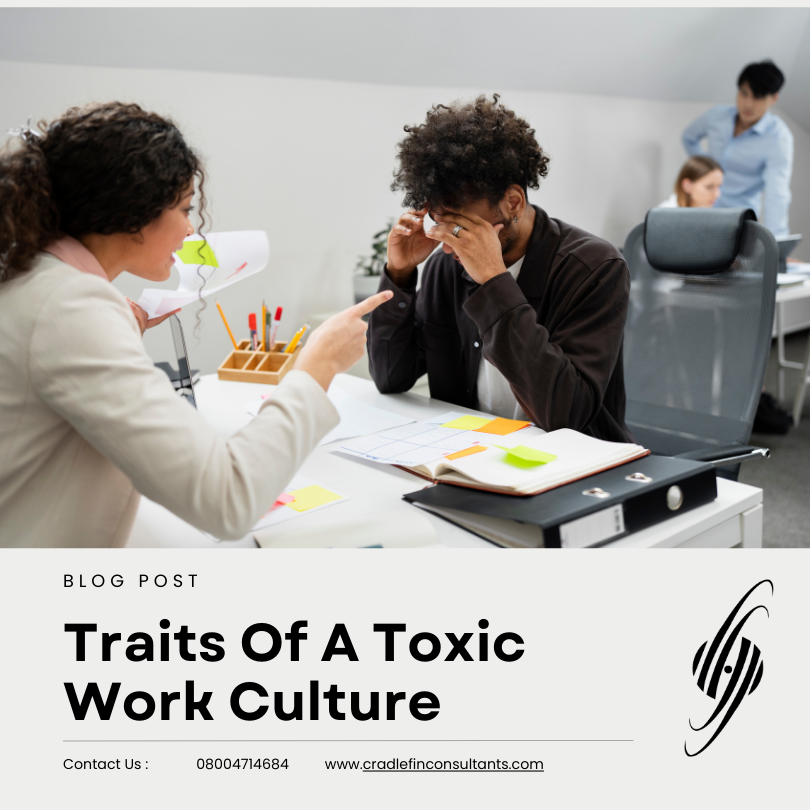Introduction:
In today’s fast-paced and competitive work environments, the culture within an organisation can significantly impact the well-being and productivity of its employees. A toxic work culture is characterised by a variety of negative traits that can lead to high turnover rates, low morale, and decreased overall performance. In this article, we will explore the common traits of a toxic work culture, ranging from lack of transparency and communication to unhealthy competition and internal politics. Understanding these key indicators can help individuals and organisations identify and address toxic behaviours to create a more positive and supportive work environment.
Traits of a Toxic Work Culture
Lack of Transparency and Communication: In a toxic work culture, transparency and communication are often lacking, leading to confusion and mistrust among employees.
Hidden Decision-Making Processes: Important decisions are made behind closed doors, leaving employees feeling disconnected and undervalued.
Information Hoarding: Knowledge is hoarded rather than shared, creating silos and hindering collaboration and innovation.
Poor Feedback Mechanisms: Feedback is scarce or non-constructive, making it difficult for employees to grow and improve.
Micromanagement and Lack of Trust: Micromanagement and lack of trust go hand in hand in toxic work cultures, stifling creativity and demotivating employees.
Excessive Monitoring and Control: Employees are constantly monitored and scrutinised, leading to a lack of autonomy and a fear of making mistakes.
Lack of Autonomy and Empowerment: Employees are not trusted to make decisions and take ownership, resulting in disempowerment and disengagement.
Constant Need for Approval: Employees feel the need to seek constant validation and approval from superiors, creating a culture of insecurity and dependency.
High Turnover and Low Morale: A toxic work culture often results in high turnover rates and low morale among employees, impacting productivity and overall well-being.
Lack of Recognition and Appreciation: Employees’ efforts are not recognised or appreciated, causing feelings of inadequacy and unfulfillment.
Unclear Expectations and Goals: Expectations and goals are ambiguous or constantly shifting, leaving employees feeling lost and demotivated.
Toxic Leadership Behavior: Leadership displays toxic behaviours such as favouritism, manipulation, or lack of integrity, setting a negative tone for the entire organisation.
Blaming and Shaming Culture: A blaming and shaming culture is toxic to the core, fostering a hostile and unproductive work environment.
Finger-Pointing and Scapegoating: Instead of taking responsibility, individuals engage in blaming others for failures, creating a culture of fear and defensiveness.
Public Humiliation and Bullying: Public humiliation and bullying tactics are used to exert power and control, causing emotional harm and deteriorating trust among team members.
Avoidance of Accountability: Accountability is avoided, and mistakes are swept under the rug rather than addressed and learnt from, perpetuating a toxic cycle of blame and evasion.
Lack of Diversity and Inclusion: In a toxic work culture, diversity and inclusion are often overlooked, leading to discriminatory practises, exclusionary behaviour, and the marginalisation of minority groups. Rather than celebrating differences and promoting equality, toxic workplaces create environments where certain individuals are unfairly treated and overlooked.
Poor Work-Life Balance: Toxic work cultures thrive on overworking and burnout, setting unrealistic expectations on personal time, and enforcing inflexible schedules and policies. Balancing work and personal life becomes a struggle, with employees feeling pressured to prioritise work at the expense of their well-being.
Resistance to Change and Innovation: In toxic work environments, there is a prevalent fear of failure and risk aversion, leading to closed-mindedness and stagnation. Innovation is stifled as employees are unwilling to adapt to new ideas, hindering growth and progress within the organisation.
Unhealthy Competition and Internal Politics: Within toxic work cultures, a cutthroat environment prevails, fuelled by rumours, gossip, and the sabotage and undermining of colleagues. Rather than fostering teamwork and collaboration, internal politics and unhealthy competition create a hostile and divisive atmosphere detrimental to overall productivity and morale.
Conclusion
Recognising and addressing the traits of a toxic work culture is essential for fostering a healthy and thriving workplace environment. By promoting transparency, trust, diversity, and a balance between work and personal life, organisations can cultivate a positive culture that enhances employee satisfaction and overall success. It is crucial for leaders and employees alike to actively work towards creating a supportive and inclusive workplace where individuals feel valued, respected, and motivated to contribute their best. By acknowledging and addressing toxic behaviours, organisations can pave the way for a more positive and productive work culture for the benefit of all.
FAQ:
Q 1: How can I identify if my workplace has a toxic culture?
A 1: Look out for signs such as lack of transparency, high turnover rates, micromanagement, and a culture of blame and negativity. Pay attention to how communication flows, how conflicts are resolved, and the overall morale of employees.
Q 2: What can employees do to address a toxic work culture?
A 2: Employees can start by addressing issues directly with their supervisors or HR department, seeking support from colleagues, and documenting instances of toxic behaviour. It’s also important to practise self-care, set boundaries, and consider seeking opportunities in healthier work environments if necessary.
Q 3: Can a toxic work culture be changed or improved?
A 3: Yes, with commitment and effort from leadership and employees, a toxic work culture can be transformed. This may involve implementing new policies, providing training on communication and conflict resolution, fostering a culture of trust and teamwork, and holding individuals accountable for their behaviour.
Q 4: How can organisations prevent a toxic work culture from developing?
A 4: Organisations can prevent a toxic work culture by prioritising values such as transparency, open communication, diversity and inclusion, and work-life balance from the outset. Regularly assessing and addressing the organisational climate, providing support for mental health and well-being, and promoting a culture of respect and collaboration can all contribute to a healthy work environment.






